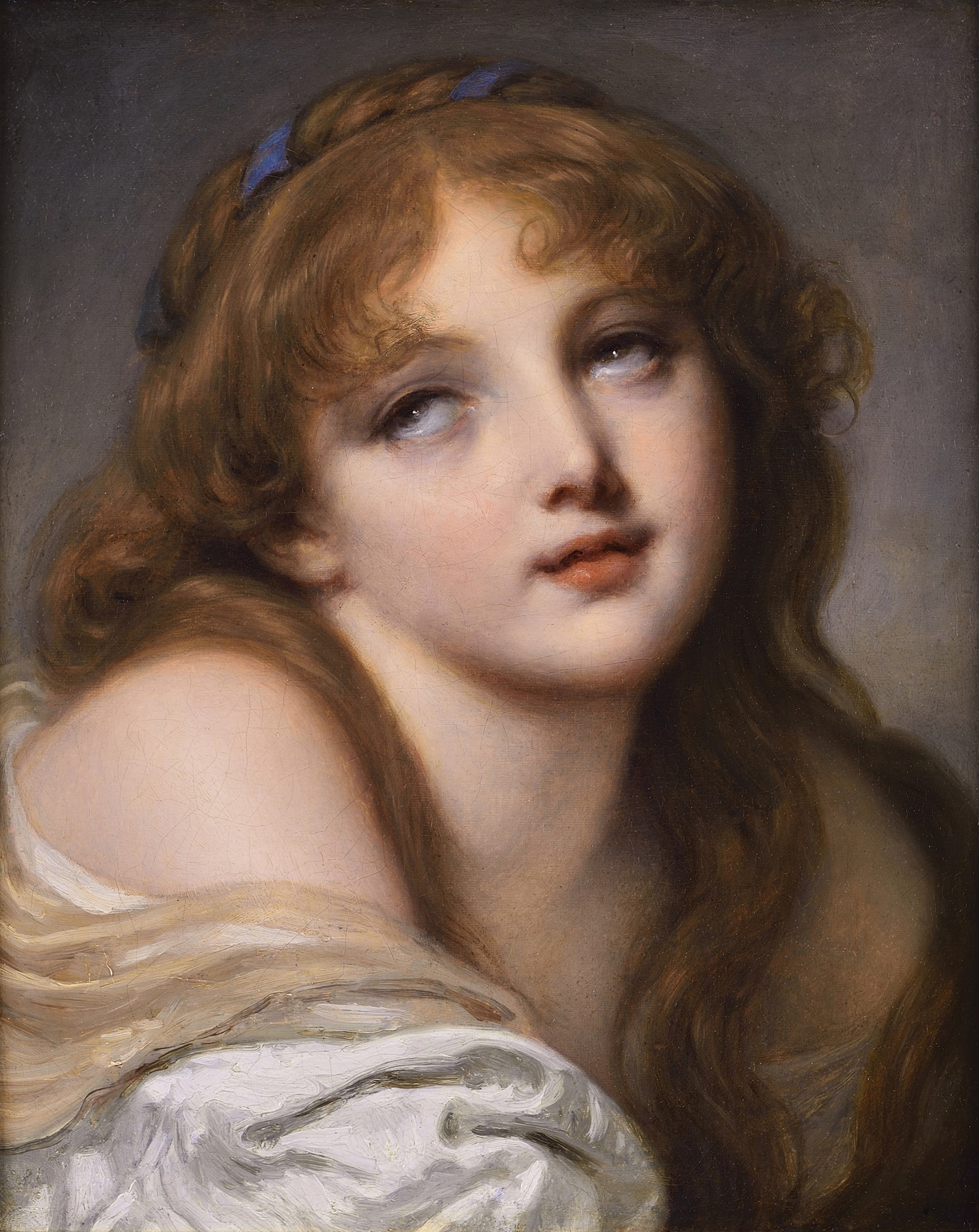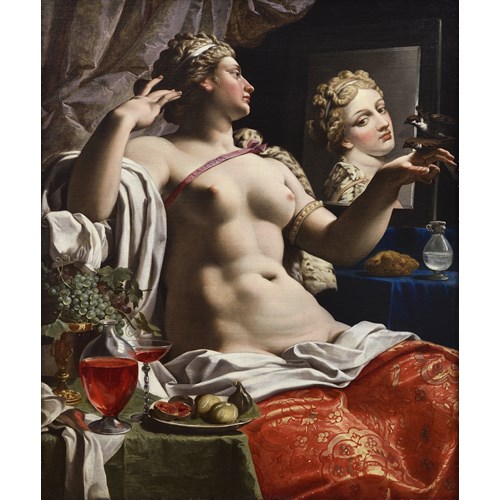Marketplace
The Last Breath of Innocence
Jean-Baptiste Greuze
The Last Breath of Innocence
Epoque 1750-1850, 18th century
Origine France
Medium Oil on canvas
Dimension 41 x 33 cm (16¹/₈ x 13 inches)
Jean Baptiste Greuze was born at Tournus on August 21, 1725. His early life is obscure, but he studied painting in Lyons and was in Paris by 1750, where he entered the Royal Academy as a student and worked with Charles Joseph Natoire, a prominent decorative painter. During the 1760s Greuze achieved a significant reputation with his sentimental paintings of peasants or lower-class people seen in humble surroundings and in the midst of theatrically emotional family situations; examples are The Village Bride (1761), The Father's Curse (1765), and The Prodigal Son (1765).
In 1769 Greuze was admitted to the academy as a genre painter. Ambitious to become a member of the academy as a history painter, which was of higher rank, he was so angered by his admission as only a genre painter that he refused to show his paintings at the academy's exhibitions (the Salons). However, by that time he had already established a successful career and could afford to ignore the Salons.
The Rococo style that dominated French painting during the 18th century was aristocratic in nature, elegant, and sensuous. Stylistically it depended upon soft colors, refined textures, free brushwork, and asymmetrical compositions based upon the interplay of curved lines and masses. Produced for highly sophisticated patrons, rococo painting concentrated on aristocratic diversions, decorative portraits, mythological and allegorical themes frequently treated in a playful or erotic manner, so clearly seen here, and idyllic pastoral scenes. Greuze's moralizing rustic dramas constituted a reaction against rococo frivolity in art; by appealing to emotion they were also a revolt against the emphasis placed upon reason and science by the philosophers of the Enlightenment, the intellectual movement that pervaded the first half of the 18th century. Greuze's work can be seen as part of a general cultural phenomenon that emphasized "sentiment" and appeared in novels, plays, poetry, and the philosophy of Jean Jacques Rousseau.
The rising importance of the middle class, and of middle-class morality, also played a part in the success of Greuze's work. He showed the virtues of the simple life, a "return to nature," and the honesty of unaffected emotion. The blatant melodrama of his preaching was not found offensive, and visitors to the Salons wept in front of his paintings. The intellectuals of the day were generally opposed to the rococo as a decadent style. Somewhat ironically, Greuze's most influential champion was Denis Diderot, a leading philosopher of the Enlightenment, who saw Greuze as "the painter of virtue, the rescuer of corrupted morality." The fashion for simplicity and the "natural man" was all pervasive and engravings of Greuze's work were popular with all classes of society. His unique works were greatly admired by connoisseurs, critics and the general public throughout most of his life. His pictures were in the collections of such noted connoisseurs as Ange-Laurent de La Live de Jully, Claude-Henri Watelet and Etienne-François, Duc de Choiseul.
In his sensual paintings of young girls, such as our Last Breath of Innocence, with their varying degrees of eroticism, pale colors, and soft tonality, his link to the rococo is most evident. By the end of the century Greuze's work, especially his many variations on the Head of a Girl, fetched record prices, and his Broken Pitcher (Paris, Louvre) was one of the most popular paintings in the Louvre.
In 1769 Greuze was admitted to the academy as a genre painter. Ambitious to become a member of the academy as a history painter, which was of higher rank, he was so angered by his admission as only a genre painter that he refused to show his paintings at the academy's exhibitions (the Salons). However, by that time he had already established a successful career and could afford to ignore the Salons.
The Rococo style that dominated French painting during the 18th century was aristocratic in nature, elegant, and sensuous. Stylistically it depended upon soft colors, refined textures, free brushwork, and asymmetrical compositions based upon the interplay of curved lines and masses. Produced for highly sophisticated patrons, rococo painting concentrated on aristocratic diversions, decorative portraits, mythological and allegorical themes frequently treated in a playful or erotic manner, so clearly seen here, and idyllic pastoral scenes. Greuze's moralizing rustic dramas constituted a reaction against rococo frivolity in art; by appealing to emotion they were also a revolt against the emphasis placed upon reason and science by the philosophers of the Enlightenment, the intellectual movement that pervaded the first half of the 18th century. Greuze's work can be seen as part of a general cultural phenomenon that emphasized "sentiment" and appeared in novels, plays, poetry, and the philosophy of Jean Jacques Rousseau.
The rising importance of the middle class, and of middle-class morality, also played a part in the success of Greuze's work. He showed the virtues of the simple life, a "return to nature," and the honesty of unaffected emotion. The blatant melodrama of his preaching was not found offensive, and visitors to the Salons wept in front of his paintings. The intellectuals of the day were generally opposed to the rococo as a decadent style. Somewhat ironically, Greuze's most influential champion was Denis Diderot, a leading philosopher of the Enlightenment, who saw Greuze as "the painter of virtue, the rescuer of corrupted morality." The fashion for simplicity and the "natural man" was all pervasive and engravings of Greuze's work were popular with all classes of society. His unique works were greatly admired by connoisseurs, critics and the general public throughout most of his life. His pictures were in the collections of such noted connoisseurs as Ange-Laurent de La Live de Jully, Claude-Henri Watelet and Etienne-François, Duc de Choiseul.
In his sensual paintings of young girls, such as our Last Breath of Innocence, with their varying degrees of eroticism, pale colors, and soft tonality, his link to the rococo is most evident. By the end of the century Greuze's work, especially his many variations on the Head of a Girl, fetched record prices, and his Broken Pitcher (Paris, Louvre) was one of the most popular paintings in the Louvre.
Epoque: 1750-1850, 18th century
Origine: France
Medium: Oil on canvas
Dimension: 41 x 33 cm (16¹/₈ x 13 inches)
Provenance: Collection of Eugene Schneider, Paris, France;
His deceased sale, Hôtel Drouot, Paris, 6-7 April 1876, lot 48;
Private collection, Madrid, Spain
Plus d'œuvres d'art de la Galerie









